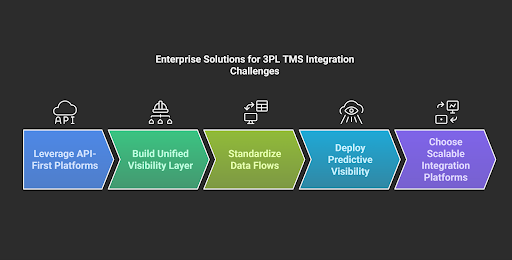- Carrier 3PL
3PL Transportation Management System Integration Challenges: How to Solve Them
Table of Contents
- Understanding 3PL Transportation Management Systems (TMS)
- Top Integration Challenges Between Enterprises and 3PL Transportation Management Systems
- Enterprise Solutions for 3PL TMS Integration Challenges
- Why FarEye Is the Enterprise Partner of Choice for 3PL TMS Integration
- Integration Excellence as the New Supply Chain Differentiator
- Frequently Asked Questions

While integrating a 3PL Transport Management System is a no-brainer for any business trying to scale operations and maximize supply chain efficiency, the process is often riddled with challenges. From data compatibility issues to security concerns for critical data, what appears to be a straightforward technical upgrade, quickly turns into a maze of complexities.
These integration challenges can slow down your operations, impact delivery performance and increase frustration in teams. So what’s the solution?
In this blog, let’s unpack these 3PL Transport Management System integration challenges and ways to solve them.
Understanding 3PL Transportation Management Systems (TMS)
A 3PL TMS refers to a Transportation Management System used by enterprises to manage shipping operations handled by third-party logistics providers. It allows businesses to coordinate planning, execution, and visibility across multiple external carriers within a single platform.
It is essential for enterprises working across air, road, sea, and rail. A 3PL transportation integration software replaces manual coordination with automated workflows, reduces latency in decision-making, and ensures control over outsourced shipping.
Core Functions of a 3PL TMS
A 3PL-integrated TMS is built to help you manage outsourced logistics with more speed, control, and accountability. These are the core functions you should expect it to deliver:
- Freight Procurement: You can centralize rate management across carriers, standardize contracts, and reduce freight spend through better visibility into negotiated terms.
- Carrier Tendering: Instead of manual assignments, the system lets you automate load tendering based on performance, cost, and service level rules.
- Route Optimization: You get smarter route decisions using real-time data, helping you cut delivery times and avoid unnecessary costs across modes.
- Compliance Management: You stay audit-ready with consistent documentation, SLA tracking, and regulatory alignment across all carriers and regions.
- Real-time Tracking: You can monitor shipments across your entire network in one place, act on exceptions earlier, and keep customers informed without delay.


Top Integration Challenges Between Enterprises and 3PL Transportation Management Systems
Integrating a 3PL transportation management system often fails due to disconnected systems, poor visibility, and outdated technology. These challenges slow down decision-making, increase errors, and limit control across multi-partner logistics networks.
Here are the most common integration challenges that continue to impact enterprise delivery performance:

Disconnected Data Ecosystems Across 3PLs and Internal Systems
Picture this. Your team manages dispatch and routing with precision inside your fleet TMS. But when an urgent customer order is handed off to a 3PL, you’re flying blind. The partner updates shipment status in a separate portal hours later. Meanwhile, your customer service team is fielding complaints about delays they didn't see coming.
Over time, this drives up costs and creates operational instability. Customers escalate issues before your systems reflect them. Teams waste hours managing updates instead of performance.
You cannot orchestrate what you cannot see. And the financial risk compounds with every blind spot.
Legacy Systems and API Incompatibility
If you’ve built a modern TMS with full API capabilities but your largest regional 3PL still does not support it, the gap kills your speed. Every new integration takes months, and exceptions are manually reconciled by ops teams which is inefficient.
The result is slower logistics, missed SLAs, and rising costs. Your TMS cannot operate as a real-time control layer without API compatibility and system alignment.
Fragmented Visibility in Multi-Carrier, Multi-Modal Networks
Think about a situation where a key international shipment starts on ocean freight, transfers to rail and then to a regional carrier. Each handoff involves a different platform which means your team must monitor 3 portals and that too with inconsistent updates.
This makes exception handling slow and unreliable. Your teams only see what one system shows, not the full picture. A disconnected network leads to missed handoffs, higher delivery risks, and weak customer communication.
Misaligned Workflows and Process Bottlenecks
If as a retailer you partner with multiple 3PLs to handle fulfillment across regions, each partner may have its own data requirements (think excel, APIs, custom portals etc.). Now if one retailer uses ‘lowest-cost carrier rule’ and assigns shipments to carriers with cheapest rates and the other one prioritizes speed, there will again be a misaligned order routing logic.
All these bottlenecks lead to manual intervention, delays, reactive order tendering and errors. It also increases shipment costs over time due to rising inefficiencies.
Security, Compliance, and Data Integrity Risks
GDPR, CCPA, and industry laws require full traceability and data governance. Without aligned protocols, you cannot guarantee audit readiness across your network. These requirements often come from customers because of the sensitive data involved such as personal information or financial records.
Each new integration point creates another entryway for data to leak, corrupt, or go untracked. If there are inadequate controls and encryption standards, it can weaken your security and compliance posture.
Enterprise Solutions for 3PL TMS Integration Challenges
Enterprise solutions for 3PL TMS integration challenges address issues like interoperability, fragmented data, limited visibility, inconsistent workflows, and poor scalability. These arise when internal systems and 3PL platforms lack alignment in architecture, data exchange, and real-time communication.
Read on to explore practical solutions to overcome integration challenges:

Leverage API-First, Cloud-Native Platforms
API-first, cloud-native platforms reduce integration risk by replacing brittle connections with reusable, secure interfaces. They allow faster onboarding of 3PLs, simplify system alignment, and eliminate the need for constant rework.
This approach also supports real-time data exchange across partners, essential for visibility, orchestration, and SLA performance. Cloud-native design gives your logistics stack built-in resilience, better uptime, and long-term scalability.
Build a Unified Visibility and Orchestration Layer
Fragmented tracking leads to delayed action, missed SLAs, and poor customer experiences. A unified visibility and orchestration layer eliminates these gaps by connecting your 3PLs, carriers, and internal systems in real-time.
With this layer in place, you track shipments across all modes, monitor SLA performance live, and respond to exceptions before they escalate. Your teams no longer operate in silos or rely on delayed manual updates.
It’s about acting faster and controlling outcomes across your logistics network.
Standardize Data and Process Flows Across Partners
When each 3PL sends different data or follows different rules, your operations slow down fast. Teams spend hours resolving mismatches, fixing failed updates, or managing delays that didn’t need to happen.
Standardizing data formats and workflows eliminates that friction. Every partner follows one structure, one SLA model, and one escalation process. You get fewer errors, faster handoffs, and less dependency on manual fixes.
Deploy Predictive Visibility and Exception Management
A 3PL transportation management system with predictive intelligence helps you act before disruption impacts service. It flags missed scans, route delays, or capacity risks across modes and partners in real-time.
Your 3PL TMS then triggers automated exception workflows, reducing manual effort and improving intervention speed. Teams stop chasing problems after the fact and start resolving them before they escalate.
This approach reduces SLA breaches, response lag, and unnecessary costs.
Choose Scalable, Low-Code Integration Platforms
Scaling your logistics network shouldn’t stall because your IT team is at capacity. A low-code 3PL transportation management system gives your operations team the tools to configure integrations.
Low-code scalable platforms like FarEye let you connect new partners through reusable, business-led workflows. That reduces onboarding time, cost, and IT dependency across your growing logistics ecosystem.
Why FarEye Is the Enterprise Partner of Choice for 3PL TMS Integration
FarEye is an AI-native logistics technology platform built for enterprise speed, visibility, and integration agility. It helps global businesses connect 3PLs faster, respond to risks earlier, and scale without disruption.
Here are the key reasons FarEye is the enterprise partner of choice for 3PL TMS integration:
Predictive Intelligence
FarEye adds predictive capabilities to your 3PL transportation management system. It identifies disruption signals early across routes, carriers, and delivery events.
Missed scans, delayed handoffs, and traffic slowdowns are flagged before they impact the customer. Teams act faster, reduce exceptions, and protect service levels without relying on escalation loops.
Rapid Deployment
FarEye integrates with existing systems through ready APIs and modular components. You avoid long implementation cycles and reduce onboarding time for new 3PLs.
This is how Creoate, one of the UK’s leading marketplaces, reduced its carrier onboarding time by 90%. The faster deployment lets them scale delivery partnerships without delaying customer commitments.
Unified Visibility
FarEye consolidates data from all your 3PLs, carriers, and transport modes into one system. You no longer switch between dashboards or chase updates across vendors.
Every shipment, delay, scan, and milestone is visible in real-time through a single interface. It makes tracking clean, proactive, and fully accountable across partners, countries, and modes.
Proven Scalability
Scaling logistics across new partners, regions, or volumes shouldn’t break existing systems. FarEye’s architecture supports growth without adding complexity or slowing execution.
One of the Middle East’s largest pharma retailers expanded from 40 to over 100 stores using FarEye. With smoother delivery orchestration, they scaled faster while improving customer experience and operational control.
Low-Code Customization
Every change in partner SLAs, delivery policies, or fulfillment priorities shouldn’t send you back to engineering. FarEye gives your operations team the ability to configure workflows, triggers, and data flows without writing code.
You respond faster to shifts in customer demand or 3PL performance without waiting on developers. That means fewer delays, less back-and-forth, and quicker decisions.
Integration Excellence as the New Supply Chain Differentiator
Winning in logistics today isn’t about having more partners. It’s about how well they connect. Enterprises that fix integration gaps move faster, adapt quicker, and earn customer loyalty in moments that matter.
Orchestration and visibility are no longer backend features, they shape frontline experience and financial outcomes. The board cares about delivery consistency now, not just operations.
With predictive control and rapid integration, FarEye turns scattered systems into a single, scalable advantage.
Watch the platform in action today and talk to an expert.
Frequently Asked Questions
How Much Does 3PL TMS Software Cost?
A 3PL transportation management system can cost you anywhere from a few thousand dollars to over a hundred thousand dollars. Pricing depends on factors like the deployment model (cloud-based or licensed), platform complexity, number of users, and level of integration required.
Why Is Integrating 3PLs With TMS Platforms So Difficult for Enterprises?
Integrating 3PLs with a transportation management system is difficult due to non-standard processes, limited IT capabilities, and inconsistent data formats. Smaller 3PLs often lack resources for real-time exchange. It becomes hard for enterprises to maintain visibility, control, and scalability across their supply chain network.
What Business Outcomes Can Enterprises Expect From Solving 3PL TMS Integration Challenges?
Solving 3PL transportation management system integration challenges enables enterprises to:
- Improve efficiency and reduce operational costs
- Gain real-time visibility and control across shipments
- Scale operations faster with less infrastructure strain
- Increase customer satisfaction through accurate, timely deliveries
- Minimize errors, claims, and fulfillment delays
- Focus internal teams on core business priorities
How Quickly Can FarEye Deploy 3PL TMS Integration for Enterprise Logistics Networks?
FarEye can deploy 3PL transportation management system integrations in a few weeks. Its API-first, cloud-native architecture, and low-code customization enable faster onboarding of logistics partners and seamless integration with existing systems.

Komal Puri is a seasoned professional in the logistics and supply chain industry. As the AVP of Marketing and a subject matter expert at FarEye, she has been instrumental in shaping the industry narrative for the past decade. Her expertise and insights have earned her numerous awards and recognition. Komal’s writings reflect her deep understanding of the industry, offering valuable insights and thought leadership.
Let's Talk to Our Experts and Optimize Your Deliveries Today!
An expert from our team will reach out within 24 hours
Related resources


